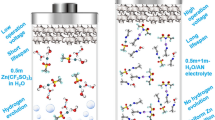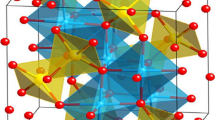Abstract
In this work, nickel nanopore arrays with a highly-oriented nanoporous structure inherited from porous alumina membranes were used as nanostructured current collectors for constructing ultrahigh rate solid-state supercapacitors. A thin layer of poly(3,4-ethylenedioxythiophene) (PEDOT) as electroactive materials was conformally coated onto nickel nanopores to form heterostructured electrodes. The as-prepared electrodes have a large specific surface area to ensure a high capacity, and the highly-oriented nanoporous structure of nickel nanopores reduces the ion transport resistance, allowing the ions in the solid-state electrolytes to quickly access the PEDOT surface during the fast charge-discharge process. As a result, the assembled solid-state supercapacitor in a symmetric configuration exhibits an ideal capacitive behavior and a superior rate capability even at an ultrahigh scan rate of 50 V∙s‒1.

Similar content being viewed by others
References
Jiang J, Li Y, Liu J, Huang X, Yuan C, Lou XWD. Recent advances in metal oxide-based electrode architecture design for electrochemical energy storage. Advanced Materials, 2012, 24(38): 5166–5180
Zhao H, Liu L, Vellacheri R, Lei Y. Recent advances in designing and fabricating self-supported nanoelectrodes for supercapacitors. Advancement of Science, 2017, 4(10): 1700188
Zhi M, Xiang C, Li J, Li M, Wu N. Nanostructured carbon-metal oxide composite electrodes for supercapacitors: A review. Nanoscale, 2013, 5(1): 72–88
Simon P, Gogotsi Y, Dunn B. Where do batteries end and supercapacitors begin? Science, 2014, 343(6176): 1210–1211
Vellacheri R, Al-Haddad A, Zhao H, Wang W, Wang C, Lei Y. High performance supercapacitor for efficient energy storage under extreme environmental temperatures. Nano Energy, 2014, 8: 231–237
Yan J, Wang Q, Wei T, Fan Z. Recent advances in design and fabrication of electrochemical supercapacitors with high energy densities. Advanced Energy Materials, 2014, 4(4): 1300816
Grote F, Kühnel R S, Balducci A, Lei Y. Template assisted fabrication of free-standing MnO2 nanotube and nanowire arrays and their application in supercapacitors. Applied Physics Letters, 2014, 104(5): 053904
Grote F, Zhao H, Lei Y. Self-supported carbon coated TiN nanotube arrays: Innovative carbon coating leads to an improved cycling ability for supercapacitor applications. Journal of Materials Chemistry. A, Materials for Energy and Sustainability, 2015, 3(7): 3465–3470
Lu Q, Chen J G, Xiao J Q. Nanostructured electrodes for highperformance pseudocapacitors. Angewandte Chemie International Edition, 2013, 52(7): 1882–1889
Mirvakili S M, Hunter I W. Vertically aligned niobium nanowire arrays for fast-charging micro-supercapacitors. Advanced Materials, 2017, 29(27): 1700671
Chen W, Cai W, Lei Y, Zhang L. A sonochemical approach to the confined synthesis of palladium nanoparticles in mesoporous silica. Materials Letters, 2001, 50(2): 53–56
Wang S, Wang M, Lei Y, Zhang L. “Anchor effect” in poly(styrene maleic anhydride)/TiO2 nanocomposites. Journal of Materials Science Letters, 1999, 18(24): 2009–2012
Yu Z, Tetard L, Zhai L, Thomas J. Supercapacitor electrode materials: Nanostructures from 0 to 3 dimensions. Energy & Environmental Science, 2015, 8(3): 702–730
Wen L, Wang Z, Mi Y, Xu R, Yu S H, Lei Y. Designing heterogeneous 1D nanostructure arrays based on AAO templates for energy applications. Small, 2015, 11(28): 3408–3428
Vellacheri R, Zhao H, Mühlstädt M, Ming J, Al-Haddad A, Wu M, Jandt K D, Lei Y. All-solid-state cable-type supercapacitors with ultrahigh rate capability. Advanced Materials Technologies, 2016, 1 (1): 1600012
Vellacheri R, Zhao H, Mühlstädt M, Al-Haddad A, Jandt K D, Lei Y. Rationally engineered electrodes for a high-performance solidstate cable-type supercapacitor. Advanced Functional Materials, 2017, 27(18): 1606696
Yang P, Chao D, Zhu C, Xia X, Zhang Y, Wang X, Sun P, Tay B K, Shen Z X, Mai W. Ultrafast-charging supercapacitors based on cornlike titanium nitride nanostructures. Advancement of Science, 2016, 3(6): 1500299
Carlberg J, Inganäs O. Poly(3,4-ethylenedioxythiophene) as electrode material in electrochemical capacitors. Journal of the Electrochemical Society, 1997, 144(4): L61–L64
Zhang H, Yu X, Braun P V. Three-dimensional bicontinuous ultrafast-charge and-discharge bulk battery electrodes. Nature Nanotechnology, 2011, 6(5): 277–281
Wen L, Mi Y, Wang C, Fang Y, Grote F, Zhao H, Zhou M, Lei Y. Cost-effective atomic layer deposition synthesis of Pt nanotube arrays: Application for high performance supercapacitor. Small, 2014, 10(15): 3162–3168
Zhao H, Wang C, Vellacheri R, Zhou M, Xu Y, Fu Q, Wu M, Grote F, Lei Y. Self-supported metallic nanopore arrays with highly oriented nanoporous structures as ideally nanostructured electrodes for supercapacitor applications. Advanced Materials, 2014, 26(45): 7654–7659
Liu L, Zhao H, Wang Y, Fang Y, Xie J, Lei Y. Evaluating the role of nanostructured current collectors in energy storage capability of supercapacitor electrodes with thick electroactive materials layer. Advanced Functional Materials, 2018, 28(6): 1705107
Portet C, Taberna P, Simon P, Laberty-Robert C. Modification of Al current collector surface by sol-gel deposit for carbon–carbon supercapacitor applications. Electrochimica Acta, 2004, 49(6): 905–912
Grote F, Lei Y. A complete three-dimensionally nanostructured asymmetric supercapacitor with high operating voltage window based on PPy and MnO2. Nano Energy, 2014, 10: 63–70
Zhang J, Wang S, Zhang S, Tao Q, Pan L, Wang Z, Zhang Z, Lei Y, Yang S, Zhao H. In situ synthesis and phase change properties of Na2SO4$10H2O@SiO2 solid nanobowls toward smart heat storage. Journal of Physical Chemistry C, 2011, 115(41): 20061–20066
Biswas S, Drzal L T. Multilayered nanoarchitecture of graphene nanosheets and polypyrrole nanowires for high performance supercapacitor electrodes. Chemistry of Materials, 2010, 22(20): 5667–5671
Pang S C, Anderson MA, Chapman T W. Novel electrode materials for thin-film ultracapacitors: Comparison of electrochemical properties of sol-gel-derived and electrodeposited manganese dioxide. Journal of the Electrochemical Society, 2000, 147(2): 444–450
Kajdos A, Kvit A, Jones F, Jagiello J, Yushin G. Tailoring the pore alignment for rapid ion transport in microporous carbons. Journal of the American Chemical Society, 2010, 132(10): 3252–3253
Gowda S R, Leela Mohana Reddy A, Zhan X, Jafry H R, Ajayan P M. 3D nanoporous nanowire current collectors for thin film microbatteries. Nano Letters, 2012, 12(3): 1198–1202
Xu C, Li Z, Yang C, Zou P, Xie B, Lin Z, Zhang Z, Li B, Kang F, Wong C P. An ultralong, highly oriented nickel-nanowire-array electrode scaffold for high-performance compressible pseudocapacitors. Advanced Materials, 2016, 28(21): 4105–4110
Zhu H, Li M, Wang D, Zhou S, Peng C. Interfacial synthesis of freestanding asymmetrical PPY-PEDOT copolymer film with 3D network structure for supercapacitors. Journal of the Electrochemical Society, 2017, 164(9): A1820–A1825
Zhao Q, Wang G, Yan K, Yan J, Wang J. Binder-free porous PEDOT electrodes for flexible supercapacitors. Journal of Applied Polymer Science, 2015, 132(41): 42549
Lei Y, Chim W, Sun H, Wilde G. Highly ordered CdS nanoparticle arrays on silicon substrates and photoluminescence properties. Applied Physics Letters, 2005, 86(10): 103106
Lang X, Hirata A, Fujita T, Chen M. Nanoporous metal/oxide hybrid electrodes for electrochemical supercapacitors. Nature Nanotechnology, 2011, 6(4): 232–236
Yang P, Xie J, Guo C, Li C M. Soft-to network hard-material for constructing both ion-and electron-conductive hierarchical porous structure to significantly boost energy density of a supercapacitor. Journal of Colloid and Interface Science, 2017, 485: 137–143
Kötz R, Carlen M. Principles and applications of electrochemical capacitors. Electrochimica Acta, 2000, 45(15): 2483–2498
Acknowledgements
The authors acknowledge funding from the European Research Council (Three Dsurface: 240144), European Research Council (HiNaPc: 737616), BMBF (ZIK-3DNanoDevice: 03Z1MN11), BMBF (Meta-ZIK-BioLithoMorphie: 03Z1M512), and German Research Foundation (DFG: LE 2249_4-1) for the financial support to this work.
Author information
Authors and Affiliations
Corresponding author
Rights and permissions
About this article
Cite this article
Zhao, H., Liu, L., Fang, Y. et al. Nickel nanopore arrays as promising current collectors for constructing solid-state supercapacitors with ultrahigh rate performance. Front. Chem. Sci. Eng. 12, 339–345 (2018). https://doi.org/10.1007/s11705-018-1699-6
Received:
Accepted:
Published:
Issue Date:
DOI: https://doi.org/10.1007/s11705-018-1699-6




